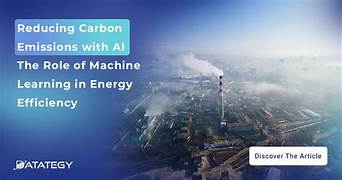AI in Tracking and Reducing Carbon Emissions
As the global community grapples with the challenges of climate change, reducing carbon emissions has become a top priority. Artificial Intelligence (AI) is emerging as a powerful tool in this effort, offering innovative solutions to monitor, analyze, and mitigate greenhouse gas emissions across various sectors. By harnessing AI, governments, businesses, and individuals can make data-driven decisions to achieve their sustainability goals more effectively.
The Importance of Tracking Carbon Emissions
Accurate tracking of carbon emissions is the first step toward meaningful reduction. Without reliable data, it’s difficult to identify major sources of emissions or measure the impact of mitigation efforts. AI enables precise tracking by leveraging advanced data collection and analysis techniques, providing real-time insights into emission levels and trends.
AI Applications in Tracking Carbon Emissions
AI is revolutionizing the way carbon emissions are monitored, enabling more accurate and efficient tracking. Here are some key applications:
1. Satellite Monitoring
AI-powered satellites are instrumental in monitoring emissions on a global scale. These satellites use machine learning algorithms to analyze images and detect changes in land use, deforestation, and industrial activity that contribute to carbon emissions. For example, NASA’s Orbiting Carbon Observatory (OCO) uses AI to map carbon dioxide levels across the planet.
2. Smart Sensors
AI-enhanced sensors deployed in industrial facilities, transportation systems, and urban areas measure emissions in real time. These sensors collect data on carbon dioxide, methane, and other greenhouse gases, which AI systems analyze to identify patterns and anomalies.
3. Supply Chain Analysis
AI tools help companies track emissions throughout their supply chains by analyzing data from production, transportation, and distribution processes. This analysis identifies high-emission activities, enabling businesses to implement targeted strategies for reduction.
4. Carbon Accounting Platforms
AI-driven platforms streamline carbon accounting by automating data collection and analysis. These platforms provide businesses with detailed reports on their carbon footprint, helping them comply with regulatory requirements and set achievable reduction targets.
AI Applications in Reducing Carbon Emissions
Beyond tracking, AI offers innovative solutions for reducing carbon emissions across various sectors. Key applications include:
1. Optimizing Energy Usage
AI systems optimize energy consumption in buildings, industries, and transportation by:
- Analyzing energy usage patterns to identify inefficiencies.
- Adjusting heating, cooling, and lighting systems in real-time based on occupancy and weather conditions.
- Recommending energy-saving practices and technologies.
For instance, Google’s DeepMind AI reduced the energy used for cooling its data centers by 40%, significantly lowering carbon emissions.
2. Enhancing Renewable Energy Integration
AI facilitates the integration of renewable energy sources into power grids by:
- Predicting energy generation from solar and wind farms based on weather forecasts.
- Balancing supply and demand in real-time to prevent energy waste.
- Identifying optimal locations for renewable energy installations.
3. Improving Transportation Efficiency
The transportation sector is a major contributor to carbon emissions. AI reduces emissions by:
- Optimizing traffic flow using real-time data from sensors and cameras.
- Enabling predictive maintenance of vehicles to improve fuel efficiency.
- Supporting the development of autonomous electric vehicles and route optimization algorithms.
4. Industrial Process Optimization
AI enhances industrial efficiency by:
- Monitoring equipment performance to reduce energy consumption.
- Identifying opportunities for process improvements that lower emissions.
- Automating repetitive tasks to minimize waste and energy use.
5. Carbon Capture and Storage (CCS)
AI plays a critical role in carbon capture and storage technologies by:
- Identifying optimal locations for carbon capture facilities.
- Monitoring the performance of CCS systems to ensure efficiency.
- Predicting the long-term stability of stored carbon.
Success Stories in AI-Driven Carbon Management
Several organizations and projects have successfully leveraged AI to track and reduce carbon emissions:
1. Microsoft’s Sustainability Initiatives
Microsoft uses AI to monitor its carbon footprint and achieve its goal of becoming carbon negative by 2030. AI tools analyze data from the company’s operations, supply chain, and energy usage, identifying opportunities for emission reductions.
2. Climate TRACE Coalition
The Climate TRACE coalition, supported by AI technology, provides real-time emissions tracking for over 70,000 sites worldwide. By analyzing satellite imagery, sensor data, and other inputs, Climate TRACE offers transparent and accurate emissions data to support global climate action.
3. Siemens Smart Buildings
Siemens uses AI to optimize energy usage in smart buildings. AI algorithms analyze occupancy patterns and environmental conditions to adjust heating, cooling, and lighting systems, reducing energy consumption and emissions.
Challenges and Limitations
Despite its potential, AI-driven carbon management faces several challenges:
1. Data Availability and Quality
AI systems require vast amounts of high-quality data to function effectively. In some regions, data collection infrastructure is limited, hindering the accuracy of emissions tracking and reduction efforts.
2. High Implementation Costs
Developing and deploying AI systems involves significant investment in technology, expertise, and infrastructure. Small and medium-sized enterprises may struggle to afford these costs.
3. Cybersecurity Risks
As AI systems become integral to carbon management, they are vulnerable to cyberattacks. Ensuring robust cybersecurity measures is essential to protect sensitive data and maintain system integrity.
4. Regulatory and Ethical Concerns
The use of AI raises ethical questions about data privacy, transparency, and accountability. Additionally, inconsistent regulatory frameworks across regions can create challenges for implementing AI-driven solutions.
The Future of AI in Carbon Management
The future of AI in tracking and reducing carbon emissions is promising, with several emerging trends:
1. AI and IoT Integration
The combination of AI and the Internet of Things (IoT) will enhance emissions tracking by providing real-time data from interconnected devices. This integration enables more precise monitoring and faster responses to emission spikes.
2. Decentralized Emission Monitoring
AI-powered blockchain technology can facilitate decentralized emissions tracking, ensuring transparency and accountability. This approach allows stakeholders to verify emission data independently.
3. Advanced Carbon Sequestration Techniques
AI will play a key role in developing advanced carbon sequestration methods, such as bioengineering and enhanced mineralization. These techniques aim to capture and store carbon more efficiently.
4. Collaborative Platforms
AI-driven platforms will enable greater collaboration among governments, businesses, and individuals. These platforms provide shared data and tools for tracking and reducing emissions, fostering collective climate action.
Conclusion
AI is revolutionizing the fight against climate change by providing innovative solutions for tracking and reducing carbon emissions. From satellite monitoring and smart sensors to renewable energy optimization and carbon capture, AI enhances efficiency and effectiveness across sectors. While challenges remain, ongoing advancements in AI technology and supportive policies will drive significant progress in global carbon management.
By embracing AI-driven solutions, society can accelerate its transition to a low-carbon economy and mitigate the impacts of climate change. The integration of AI into carbon management strategies represents a critical step toward a sustainable and resilient future.


